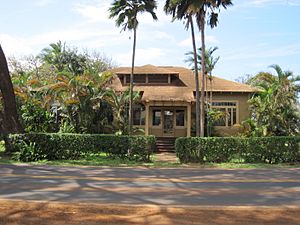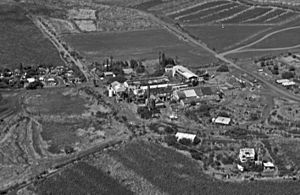- This page was last modified on 17 October 2025, at 10:18. Suggest an edit.
Alexander & Baldwin Sugar Museum facts for kids
The Alexander & Baldwin Sugar Museum is a cool place to visit in Puʻunene, Hawaii, on the island of Maui. This museum teaches you all about the history of sugarcane in Hawaii. It also tells the story of a big company called Alexander & Baldwin and how they helped grow the sugar industry. Even today, the company is still around, though it does many different things. The museum itself is located in what used to be the house of the sugar mill manager.
Contents
The Start of a Sweet Business
The story of Alexander & Baldwin began with two friends, Samuel Thomas Alexander and Henry Perrine Baldwin. Samuel Alexander was a reverend who came to Hawaii. In 1863, he started managing a sugar plantation called Waiheʻe. He hired Henry Baldwin to help him.
In 1870, Alexander started his own sugar farm, Samuel T Alexander & Co. He and Baldwin bought a large piece of land, about 561 acres, between Pāʻia and Makawao. Here, they grew sugarcane. Alexander also managed another sugar mill called Haʻikū sugar mill.
Bringing Water to the Fields
Growing sugarcane needs a lot of water. The land in Pāʻia was quite dry. But miles away, on the slopes of Haleakalā mountain, there was plenty of rain. Alexander had a great idea: build a long water channel, called an aqueduct, to bring water from the rainy side of the mountain to their dry fields.
This aqueduct was a huge project, about 17 miles long! Alexander learned about old Hawaiian irrigation systems. He made a deal with King Kalākaua to use the water. Work on the aqueduct started in 1876 and finished two years later in 1878. It cost more than they expected, but it was very important for their sugar business.
Growing the Company
After the aqueduct was built, the company grew quickly. They even sold water to other sugar farms nearby. The company was later renamed Alexander & Baldwin Plantation. In 1884, Alexander helped buy a sugar refinery in California. He also helped create a group of Hawaiian sugar planters called the Sugar Factors. This group later became the California and Hawaiian Sugar Company (C&H).
Between 1872 and 1900, the company bought more land and sugar mills. In 1898, Alexander and Baldwin bought a big part of a rival company, Hawaiian Commercial & Sugar Company. By 1899, they also owned two railroad lines on Maui. On June 30, 1900, the company officially became Alexander & Baldwin, Ltd..
Expanding the Business
The irrigation projects made a lot of money. This allowed Alexander and Baldwin to buy out other sugar farmers and make their company even bigger.
In 1877, Baldwin built the Hamakuapoko Mill. The Pāʻia Mill opened in 1880. In 1881, the Kahului Railroad helped transport the sugar by train to the port of Kahului. This made it easier to ship the sugar.
In 1888, Henry Baldwin and some other business people started the Haleakala Ranch. This was a huge ranch on the slopes of the Haleakalā volcano. Part of this land, Piʻiholo Ranch, is now used for tourism.
Challenges and More Growth
In 1889, a new law called the McKinley Tariff made sugar more expensive to sell in the U.S. This caused sugar prices to drop. Baldwin used this time to buy land at lower prices. He also built another irrigation project on Kauaʻi island called the Hanapepe ditch.
In 1894, Alexander and Baldwin officially partnered to sell their sugar in California. In 1900, this partnership became the company we know today, Alexander & Baldwin (A&B). They had offices in Honolulu and San Francisco. A&B also became an agent for other sugar plantations. Over time, A&B grew into a large company that owned many other businesses, including the shipping line Matson Navigation Company.
In 1899, Baldwin oversaw another irrigation project in Kihei. He also became an owner of The Maui News newspaper in 1905. His family continued to own the paper until 2000.
A Lasting Impact
Alexander & Baldwin became one of the "Big Five" corporations. These five companies had a huge impact on the economy of Hawaii. Today, A&B is listed on the New York Stock Exchange. It continues to be a major company and still operates the sugar museum on Maui.
See also
Website
- Alexander & Baldwin Sugar Museum website
20°52′09″N 156°27′18″W / 20.8693°N 156.4551°W




